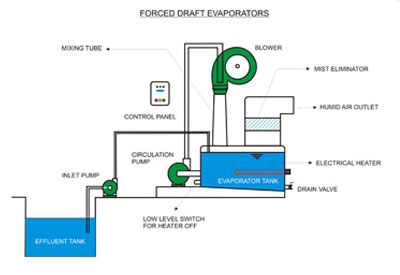
Evaporators
3R Technology offers modular designs of Atmospheric, Low Temperature Vacuum and Mechanical Vapor Compression Evaporators. Multiple effects of Vacuum and MVC Evaporators are made for higher thermal efficiency and higher volumes.
Atmospheric Forced Draft Evaporator
Where the quantity of wastewater is small and difficult to treat, atmospheric forced draft evaporator is the ideal choice. Various models from 100 to 5000 Liters per day capacities are standard.
Advantages and Features
Working Principle

Atmospheric evaporator consists of Feed Pump, Evaporator Tank with Electrical or Diesel Heater, Circulation Pump, Blower, Mixing tube, Mist Eliminator and Humid air Outlet. The wastewater from the wastewater tank is pumped by the feed Pump to the evaporator tank. Electric or Diesel heater heats the effluent in the evaporator tank. The hot effluent is pumped into the Mixing Tube, through which air is blown from atmosphere by the blower. The air and wastewater are thoroughly mixed in the mixing tube and passes to the evaporator tank, before getting out through the Mist eliminator and humid air outlet. Electrical controls limits the operation of feed pump, circulation pump and blower depends on the levels in the evaporator tank and wastewater tank. Control system with automatic ON/OFF, safety shut off and switch gears with control panel are provided with the system.
Applications
Low Temperature Vacuum Evaporator
The low temperature vacuum evaporator vaporizes water at lower temperature around 40 Deg. C than normal 100 Deg. C due to vacuum. Hence vacuum evaporators are useful for
- recovery of heat sensitive chemicals such as cyanide plating baths,
- recovery of chemicals sensitive to air oxidation such as
cyanide plating bath and Stannous tin bath
- recovery of solutions containing volatile components
Working Principle

The low temperature vacuum evaporator mainly consists of an evaporator tank 2, evaporator heat exchanger 4, process water circulation pump 3, refrigerant compressor 8, condenser heat exchanger 7, distillate tank 11, vacuum producing venture 13, and distillate circulating pump 12. The feed water enters the evaporator tank 2, and the feed water is circulated by the pump 3 to evaporator heat exchanger 4, where the feed water is heated by high pressure refrigerant from the refrigerant compressor 8. The hot water flashes as water vapor into the evaporator tank at the top. This water vapor passes through the mist eliminator 16 and the condenser heat exchanger 7. The refrigerant from the evaporator heat exchanger passes through air cooler and expansion valve and becomes cool liquid. The cool refrigerant cools the hot water vapor to distillate. The distillate is collected in the distillate tank. The distillate is circulated by the distillate circulation pump through a venture, which produces vacuum in the evaporator tank. The vacuum produced by the venturi in the evaporation tank causes process water boils between 40 to 50 Deg. C. The concentrated process water from the evaporator tank and the distillate from the distillate tank are automatically drained by the electrical controls. All necessary controls and switch gears are part of the system.
Advantages and features
Application
Mechanical Vapor Recompression
3R Technology offers MVR (Mechanical Vapor Recompression) and Multiple Effect Evaporators for large volumes and energy economy.
MVR is very energy efficient, since the latent heat of vaporization is fully utilized through vapor recompression and condensation. Typical layout of a MVR Evaporator is shown in figure.
Working Principle

Advantages and application
The major advantage of MVR is the energy economy. Typical MVR energy requirement is 0.05 to 0.15 kwh per kg of water evaporated. Water evaporation for a Triple Effect Evaporator to 120 kcal for a six effect evaporator. As the operating cost of MVR is low, large flow system favors its application in all sectors of industry and also desalination of sea and brackish water.

